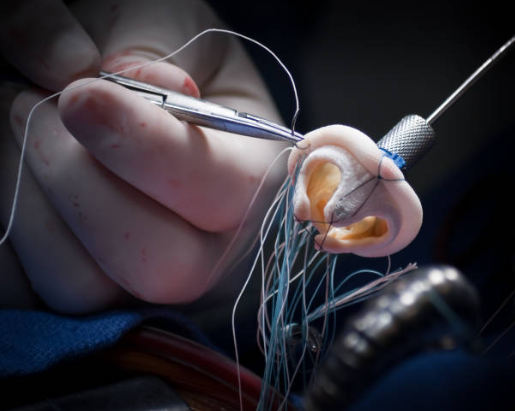İçindekiler Tablosu
What is Mitral Valve Insufficiency?
Symptoms of mitral valve insufficiency are generally ignored by patients because they are attributed to reasons such as stress, smoking and fatigue. Mitral insufficiency, which is an insidiously progressive disease, does not cause many symptoms in the early stages of the disease. For this reason, the diagnosis of mitral valve diseases usually occurs incidentally during checks performed for a different disease.
In mitral valve diseases; Insufficiency, stenosis, and both insufficiency and stenosis may be observed. The causes of mitral valve diseases are as follows:

- After the microbe called beta streptococcus infects the throat and joints, the defense mechanism developed by the body affects the heart valves in later ages and the valves become calcified,
- Birth-related causes,
- Deterioration of the mitral valve after a heart attack at an older age
Mitral kapak hastalıklarının %80-85’i çocukken geçirilen iltihaplı hastalıklara bağlı olarak meydana gelir. Kalbin sol kulakçığı ile sol karıncığı arasında yer alan mitral kapağın kireçlenmesi ya da dokunun zedelenmesi sonrası kalp kapağında kaçak ve yetmezlik oluşabilir.
Symptoms of Mitral Valve Insufficiency
- Shortness of breath,
- Palpitation,
- Don't get tired easily,
- arrhythmia,
- Heart 'fluttering'
Since symptoms of mitral valve insufficiency are often attributed to other causes, they are not given much importance by patients. Mitral valve diseases can be detected by echocardiography after patients who have consulted a doctor for different reasons are referred to cardiovascular surgery.
WHAT IS MITRAL STENOSIS? HOW IS IT OPERATED?
On the other hand, the entry point of the surgery provides excellent visibility and access, especially in terms of mitral valve exposure. This is another factor that reduces complications. If both mitral and aortic valve replacement is required due to the different entry elevations, Aortic and mitral valve (double valve) surgery should not be performed with this technique. In such cases, the anterior incision, ministernotomy, is more useful and does not cause any entry site complications.
Technical : The patient is placed on the left side of the chest under double lumen intubation and general anesthesia; that is, the anterolateral thoracotomy position is given with the chest right side up. A vertical 6 cm incision is made over the intersection of the subaxillary line and the right breast line, and the pectoralis major and pectoralis minor are incised. without cutting the muscles dissected and retractor placed, thorax is entered through 4th intercostal space and right lung ventilation is closed or if not tolerated tidal volume is decreased. Pericardium is opened and its leaves are hung on the chest wall. Aorta, right and left atrium are clearly seen. After turning the aorta with pedicle, it is suspended and aorta and right auricle, right atrium are easily cannulated. Patient is connected to heart lung pump, extra-corporeally transferred, ventilation is stopped and x-clamp is placed on aorta. Cardiac arrest is provided by applying cold blood cardioplegia and topical cold serum physiological. Left atrium is opened and mitral valve image is clear. Left atrium is closed after repair or replacement. Patient is warmed, heart is defibrillated if necessary, after working, pump is stopped by decreasing flow. The heart is easily decannulated. After bleeding control, a single chest drain is placed in the thorax (drain placement is important to avoid pain), the ribs are approximated, and the muscles and subcutaneous tissue are closed according to the procedure. Postoperative follow-up is the same.
While this intervention technique can be applied to any patient, it is only In some cases it should not be preferred. These :
- Those with advanced lung problems
- Those over 75 years of age,
- Double valve replacement (Aortic and Mitral) required,
- It should never be applied to patients requiring aortic valve surgery for the second time.
How is Mitral Valve Insufficiency Treated?
Early diagnosis and treatment are of great importance in the treatment of heart valve diseases. If the insufficiency or stenosis problem in the heart valves progresses too much, treatment may become difficult. Today, using minimally invasive surgery, heart valve repair or replacement can be performed from the side chest wall, lower end of the chest or under the armpit. Mitral valve surgery performed using closed heart surgery methods allows patients to return to their daily lives in a shorter time. However, the risk of bleeding after closed heart surgery is lower and patients do not experience pain complaints as in open surgery.
What Happens If Mitral Valve Diseases Are Untreated?
If mitral valve insufficiency or stenosis problems are not treated, blood pools in the lungs and lung blood pressure rises. This condition, which causes heart failure, can be life-threatening. Performed with minimally invasive surgery mitral valve surgery While it has a high success rate, it also provides advantages in terms of patient comfort.


3 comments
Abdulmecid
August 20, 2022 at 5:11 pm
I have all of them, I wonder if this is mitral heart failure?
Abdulmecid
August 20, 2022 at 5:12 pm
I have all of them, does this mean I have mitral heart failure?
Ayse
September 16, 2022 at 10:36 am
Sir, I have mitral valve insufficiency and I am very bad, I am sorry, I have no life left, I cannot sleep, I cannot walk, please help me.